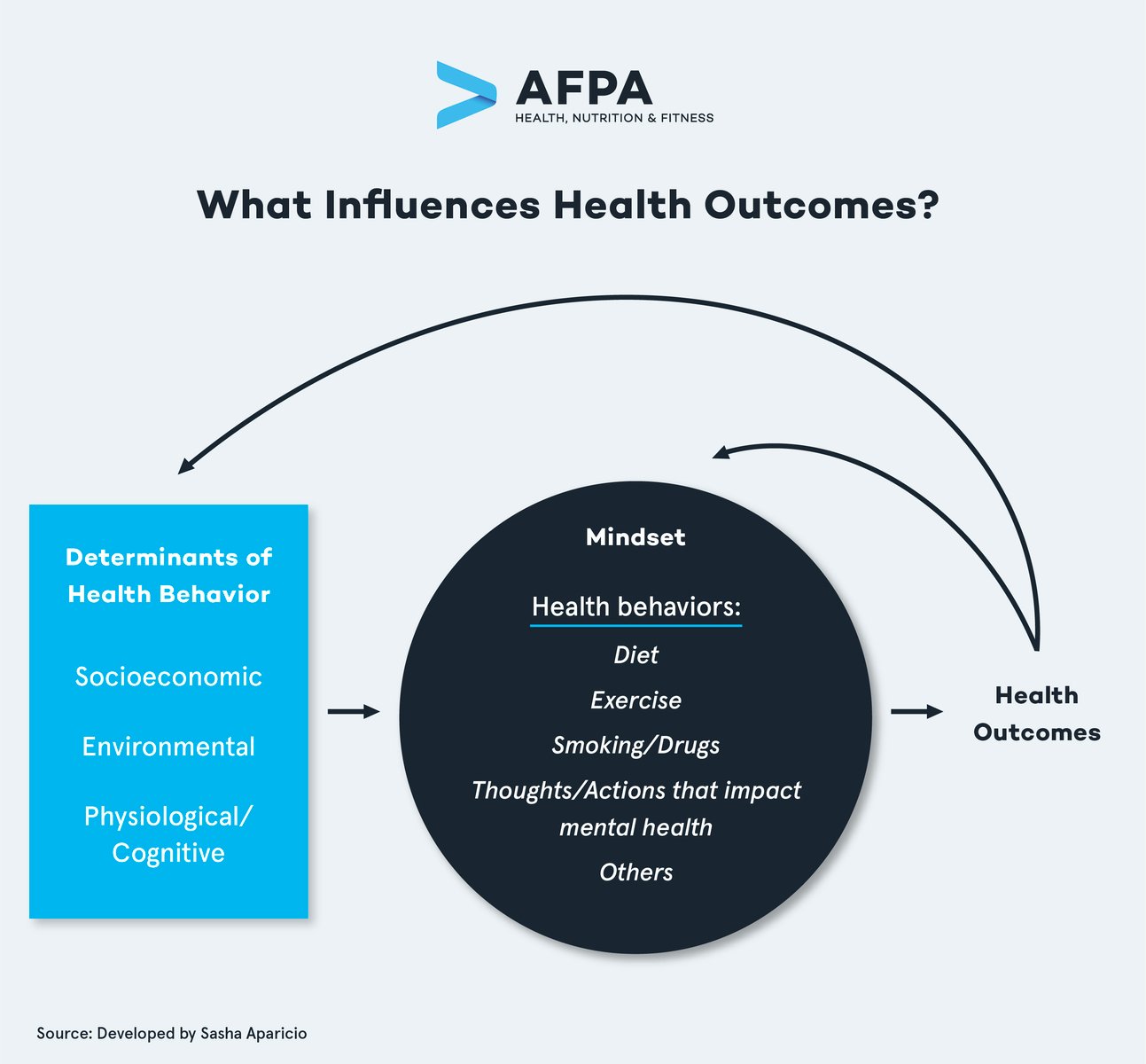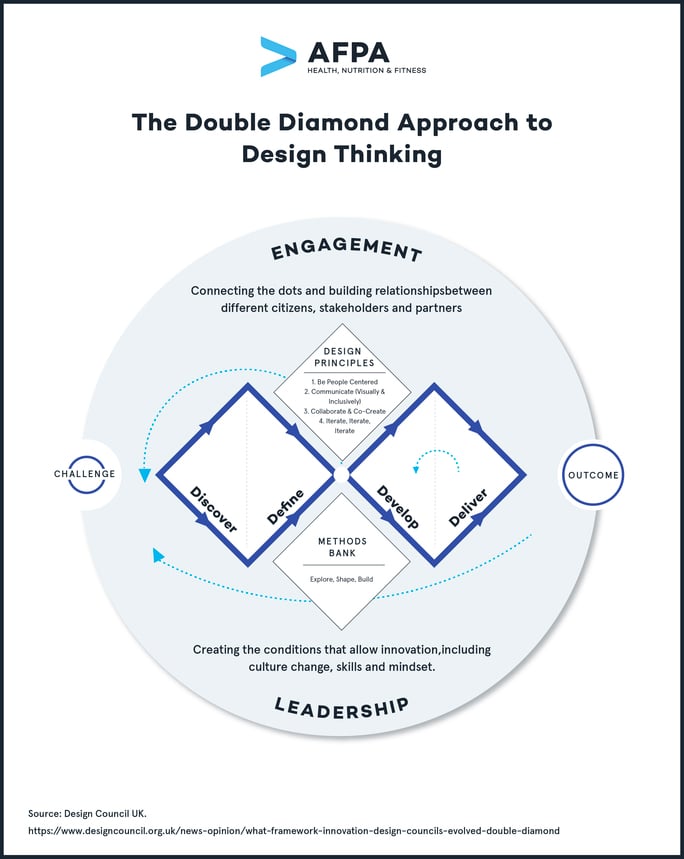One of the biggest challenges for health and wellness coaches and clients alike lies in identifying which habits can be improved and how to achieve a sustained change in the long term.
Before embarking on a healthy lifestyle journey with a client, you must ask yourself if the goal is to achieve a health behavior change or a mindset change? To decide, you should know the difference between the two and understand how they are intimately connected in effective health strategies.
This article will give you an overview of health behavior change and mindset change, and also introduce you to Design Thinking as one of many strategies for how to help your clients adopt long-term health-related habits and lifestyle modifications.
Table of Contents
Behavior Change vs Mindset Change
How to Develop a Growth Mindset
The Connection Between Health Behavior and Mindset
Using a Design Thinking Mindset in Health Coaching
The Double Diamond Approach to Design Thinking
Behavior Change and Mindset Change: What’s the Difference?
Mindsets
A mindset is a set of beliefs and assumptions regarding how malleable specific attributes are in the world around you. From a psychological perspective, there are two types of mindsets: fixed mindsets and growth mindsets.
People with fixed mindsets have beliefs that are fixed and unchangeable. A client with a fixed mindset is unwilling or unable to change their way of viewing their condition and challenges. A coach with a fixed mindset might believe that clients either have the natural ability to change behavior or they don’t.
If we look at the Transtheoretical Model of health behavior change below, a client with a fixed mindset might not be able to move beyond the contemplation stage. They recognize a need to change but face barriers to change. On the other hand, a coach with a fixed mindset may assume that a client doesn’t have the willingness or ability to move beyond the contemplation stage and, as a result, doesn’t offer useful tools to help them migrate to the preparation stage or beyond.
On the other hand, people with growth mindsets have beliefs that can change with more information, critical thought, and commitment. Clients and patients need to adopt growth mindsets to imagine the possibility of change in their lives and improve their subjective well-being. Coaches also need to have growth mindsets to view their clients as experts on their personal experience and be open to modifying methods and techniques as they arm themselves with new information.
How to Develop a Growth Mindset
It is possible to develop a growth mindset in health either in yourself or in your client. Some of the ways to do this include:
- Acknowledging and embracing imperfections
- Viewing challenges as opportunities
- Trying new and different ways of achieving the same goal
- Informing yourself with the latest research and guidelines around health conditions and chronic illness prevention
- Valuing the process over the result
- Celebrating growth with others
- Rewarding actions rather than traits
- Emphasizing growth over speed
- Recognizing improvements even when the goals haven’t been reached
- Placing effort before talent
- Learning from mistakes
- Making new goals for every goal achieved
The Design Thinking approach, which we describe below, embraces many of the principles mentioned above. So, as you move toward modifying health behaviors, you are simultaneously developing a growth mindset.

Get Your Free Guide
Learn How to Start a Fulfilling, Impactful Career as a Holistic Health Coach
You’ll learn:
- Why holistic health matters
- If holistic health coaching is right for you
- What career opportunities exist for health coaches
- And more!
Health Behaviors
To understand health behavior change, you must understand what constitutes a health behavior.
Experts define health behaviors as actions or activities that individuals undertake to maintain or improve their health, prevent health issues, slow disease progression or regression, or achieve what they perceive as a positive body image.
Health behaviors are not entirely individual choices. They are influenced by social determinants, like ideologies, discrimination, inequalities, and agency; environmental determinants, like access to safe sidewalks and a variety of low-cost food; and psychological determinants, like anxiety, depression, eating disorders, and addictions.
Remember that health professionals should not separate health behaviors from health outcomes. When a person seeks health behavior change, either in themselves, in a patient, or in an individual they are coaching, they aim to modify or replace current behaviors with those perceived to favor better health outcomes.
Some health outcomes may be easily measurable, like weight gain or weight loss and triglyceride or cholesterol levels. Other outcomes, like motivation and a sense of well-being, may be more challenging to measure but are equally important.
The Connection Between Health Behavior and Mindset
The diagram below summarizes the relationship between mindset, health behaviors, health determinants, and health outcomes.

AFPA published an article on the topic of behavior change science, which we encourage you to read to gain a better understanding of health behaviors and the theories behind achieving long-term health behavior change.
Looking in the Mirror: Coach Mindset
Health professionals are often thinking about their clients’ mindsets and how these influence their clients’ health journeys. However, as the coach, your mindset is of primary importance before thinking about the potential influence you can have on your clients. Your clients’ way of looking at their health and well-being will be significantly influenced by your mindset and understanding of everything from what influences health behavior to the “ideal” behaviors to adopt.
To illustrate the influence a coach’s mindset can have on their clients’ mindset, and therefore, client behavior, let’s look at a couple of theoretical examples.
- Example 1: The Bootstrap Health Coach
A certified health and nutrition coach has been working with clients for over ten years. She has developed her practice based on the beliefs that every individual has the sole responsibility for their health, and external factors are simply “excuses” for not being able to follow their meal and exercise plans.
In this case, the coach’s mindset will prevent her from seeing the other factors that influence health behaviors that are not in her clients’ control. Perhaps a client lives in a food desert and has limited access to fresh foods, or their income can’t cover the cost of the foods on the meal plan she has left them, or a lifetime of being pressured by their family to diet has caused a trauma response to food restrictions.
- Example 2: The “Skinny Is Healthy” Fitness Coach
A fitness coach was inspired to get certified in fitness coaching after loving the physique of professional bodybuilders. He always looked up to them as the “ideal” body type and equated their low body fat with health.
After getting his certification, he opened up a fitness coaching business for people who want to get fit at the gym. His methods are guided by the belief that a person must have a low body fat percentage to be healthy or achieve an “ideal” physique.
While this coach’s mindset may help bodybuilding athletes achieve competitive standards of body composition, he assumes that body composition is the best way to measure health status. This assumption could affect his ability to identify health issues in people with high muscle and low body fat percentages because he assumes that their body composition equates to health. In reality, however, people with body compositions with low fat and high muscle percentages may also be battling chronic diseases, eating disorders, and nutrient imbalances.
Additionally, this mindset will negatively affect the coach’s relationship with clients who have body types with higher body fat percentages, even if it doesn’t affect their strength, health status, or ability to carry out challenging exercises. This mindset could also be incredibly damaging to individuals who have a positive body image regardless of body composition and want to exercise for health, not achieve a particular physique.
Over time, the coach’s mindset, which influences what the coach says and treats his clients, could negatively affect his clients’ mental health.
Coaches’ Mindsets Influence Clients’ Mindsets
One important thing to keep in mind is that coaches are seen as experts and teachers by their clients. They believe that their coaches know how to evaluate a person’s health status and that they are experts on how to support their clients in achieving realistic lifestyle modifications.
In other words, coaches’ mindsets will have an impact on their clients’ mindset. A coach’s position is ultimately one of power but also of responsibility.
Thus, coaches must continue to educate themselves and gain sensitivity to the complex factors that influence health behaviors, including environmental and social aspects.
An Innovative Solution to Achieving Behavior Change: A Design Thinking Mindset in Health Coaching
Health behavior change theories, like the Health Belief Model and the Transtheoretical Model we describe in detail here, are effective ways of understanding what factors can influence a person’s actions that affect their health and well-being in the short and long term. They are also helpful for understanding where a person might be on the continuum of adopting healthy habits.
However, health behavior change theories are limited in offering concrete tools for helping coaches work with clients to adopt actions that support their long-term health while still being sensitive to experiential differences, like those related to race, culture, trauma, discrimination, socioeconomic status, gender, and others.
One approach to promoting healthy behaviors is by applying a concept called “Design Thinking” into health coaching. Note that this is only one approach to practically achieving health behavior change in health settings.
From Theory to Action with Design Thinking
Several groups of researchers, including one in the US and another in Brazil, have proposed using Design Thinking in the health field to improve healthcare quality, patient outcomes, and overall patient experience.
Design Thinking is an approach applied to many fields, from engineering to entrepreneurship to healthcare, that prioritizes a deep sense of empathy for end-user desires, needs, and challenges. With this approach, health providers, like health coaches, can fully understand a problem to develop a comprehensive and effective solution that meets a client’s needs.
With the growing interest in applying Design Thinking to healthcare, healthcare authorities decided to evaluate the potential of Design Thinking in healthcare.
The CDC published a systematic review of studies on the application of Design Thinking in healthcare. The study found that Design Thinking can be used in varied settings and circumstances. In general, compared to traditional interventions, the healthcare solutions created showed better usability, effectiveness, and patient satisfaction than conventional approaches.
Thus, Design Thinking applied effectively is likely a useful approach to achieving health behavior change in a health coaching environment.
Design Thinking Principles
Here we summarize Design Thinking principles based on four pillars that directly influence a health coach’s mindset when working with clients: empathy, inclusive communication, collaboration, and experimentation. Note that if you go deeper into research on design thinking, the number and division of pillars may vary slightly between thinkers.
Empathy
In the most basic sense, empathy involves the human ability to understand a person’s feelings and perspectives and why they may carry out specific actions. The first step in Design Thinking in the healthcare environment, including health coaching, is to put people first to make an effort to truly understand why a person thinks, makes decisions, and takes actions that affect their health as they do.
Effective interviewing techniques are essential for taking the first steps in developing empathy. Still, health professionals must keep communication lines open and regularly check in with patients and clients throughout the intervention process.
Inclusive Communication
Once you have listened to your client and identified problems that you perceive as being barriers to their health and well-being, it is important to share those insights using visual communication tools and having an open mind to change those perceptions.
Let’s take a theoretical example.
During the first consultation and interview process, your client reveals she is worried she might be on the road to developing type 2 diabetes because she was recently diagnosed with pre-diabetes at her yearly checkup.
When you ask her what elements of her lifestyle she thinks contribute to the development of diabetes, she tells you it is her diet and her lack of physical activity. She says that she doesn’t exercise because she doesn’t feel safe going outdoors in her neighborhood, and even though she likes cooking, she eats a lot of take-out food because she has irregular work hours.
As a coach, you can activate inclusive communication by confirming that, just as she has identified, research shows that inactivity and specific dietary patterns do increase diabetes risk.
You can also tell her that you understand, based on what she shared with you, that there are additional problems, like irregular hours and not feeling comfortable doing physical activity outdoors. By saying what you have identified as a problem out loud, you allow your client to confirm or clarify your thinking. It also allows them to ask questions about the connection between physical activity and diet and diabetes risk.
Collaboration
Which house of the following two houses would you like to live in most: One that was selected for you based on assumptions about how you like to live, or one where you work with an architect to co-design yourself?
You’ll likely prefer to live in the second house because your voice was heard in creating functional spaces for you and your family.
Collaboration is an essential principle of design thinking in healthcare. When a client has a voice concerning the best way to adopt healthier actions in ways that consider physical, economic, and social barriers and limitations, they will be much more likely to follow suit.
Experimentation
“Experimentation” doesn’t mean, by any means, that you should experiment with unfounded methods with your clients.
Experimentation refers to stepping away from one-size-fits-all solutions instead of adopting personalized solutions that respond to communities’ and individuals’ needs and realities.
As health coaches, you explore research-supported methods for approaching problems and evaluate whether they can be applied within the collaborative plan you have built with your client.
Then, you work with your client to implement these changes. While your client does so, you keep in mind that you are essentially seeing if the designed method is working with your client. You do this by checking in regularly, measuring progress, and making adjustments to goals and actions where necessary.
Applying Design Thinking in Health Coaching: The Double Diamond
Healthcare researchers explored the application of the Double Diamond approach developed by the Design Council to improve health outcomes.

The Double Diamond framework proposes a way of applying the four principles of Design Thinking. The diamonds put together modes of exploring an idea more widely with taking focused action.
The first diamond is to discover and define. Through empathetically connecting with your clients and using inclusive communication, you can specify one or several health challenges they are facing.
In the second diamond, you keep the challenge in mind. You work with your clients to develop and implement a solution that will result in modified health behaviors and, ultimately, the desired health outcomes. You check in regularly and modify the method if needed. If your client doesn’t experience the desired changes, the next step is to re-examine the framing of the problem or the timeline.
Throughout the process, you can depend on your research-backed methods bank and coach toolbox to support you in the logic for achieving certain outcomes or modifying certain behaviors and giving you the tools to do so.
The double diamond is framed within the leadership you have as a coach to guide them toward their goals. Your clients also develop the leadership take control over their health. Engagement throughout the process can make all the difference when it comes to building a collaborative relationship with your client, where you bring the expertise on health and they bring the expertise on their life experience.
Main Takeaways
In many ways, supporting your clients to adopt healthy lifestyles through health behaviors is at the core of health coaching. By nature, coaches step away from one-size-fits-all solutions and listen to clients’ unique challenges and goals to support them in making realistic shifts in the choices they make. The goal is to improve health outcomes, whether it be as measurable as lower cholesterol levels or as holistic as increasing a sense of well-being.
The challenge for health practitioners, health coaches included, is to take all of the research on health-promoting lifestyles and make them applicable to people from diverse backgrounds.
Just as mindsets influence clients’ health behaviors, they influence a coach’s approach to managing clients’ health challenges. One of the ways to ground health behavior change theory is by using a Design Thinking mindset to understand health challenges through empathy and observation, co-create solutions with clients, and apply interventions while being open to making adjustments along the way.
Want to Learn More?
Become an AFPA-Certified Holistic Health Coach to learn all about coaching clients to reach and sustain their wellness goals.
Already a practicing coach? Learn the top strategies for unlocking behavior change and earn 6.0 AFPA CECs.

Get Your Free Guide
Learn How to Start a Fulfilling, Impactful Career as a Holistic Health Coach
You’ll learn:
- Why holistic health matters
- If holistic health coaching is right for you
- What career opportunities exist for health coaches
- And more!

Author Bio
Sasha Aparicio, M.S.
Sasha Aparicio, MS, is a Food and Nutrition Anthropologist with a BA from Tufts University, and an MS in Food and Nutrition from the University of San Carlos. Sasha is a Certified Nutrition Coach and an experienced adult educator, university professor, instructional designer, program director, content writer, researcher, and health content strategist. Over the course of her career, she has worked in international development, public health, consumer qualitative research, and nutrition program management, among others.



